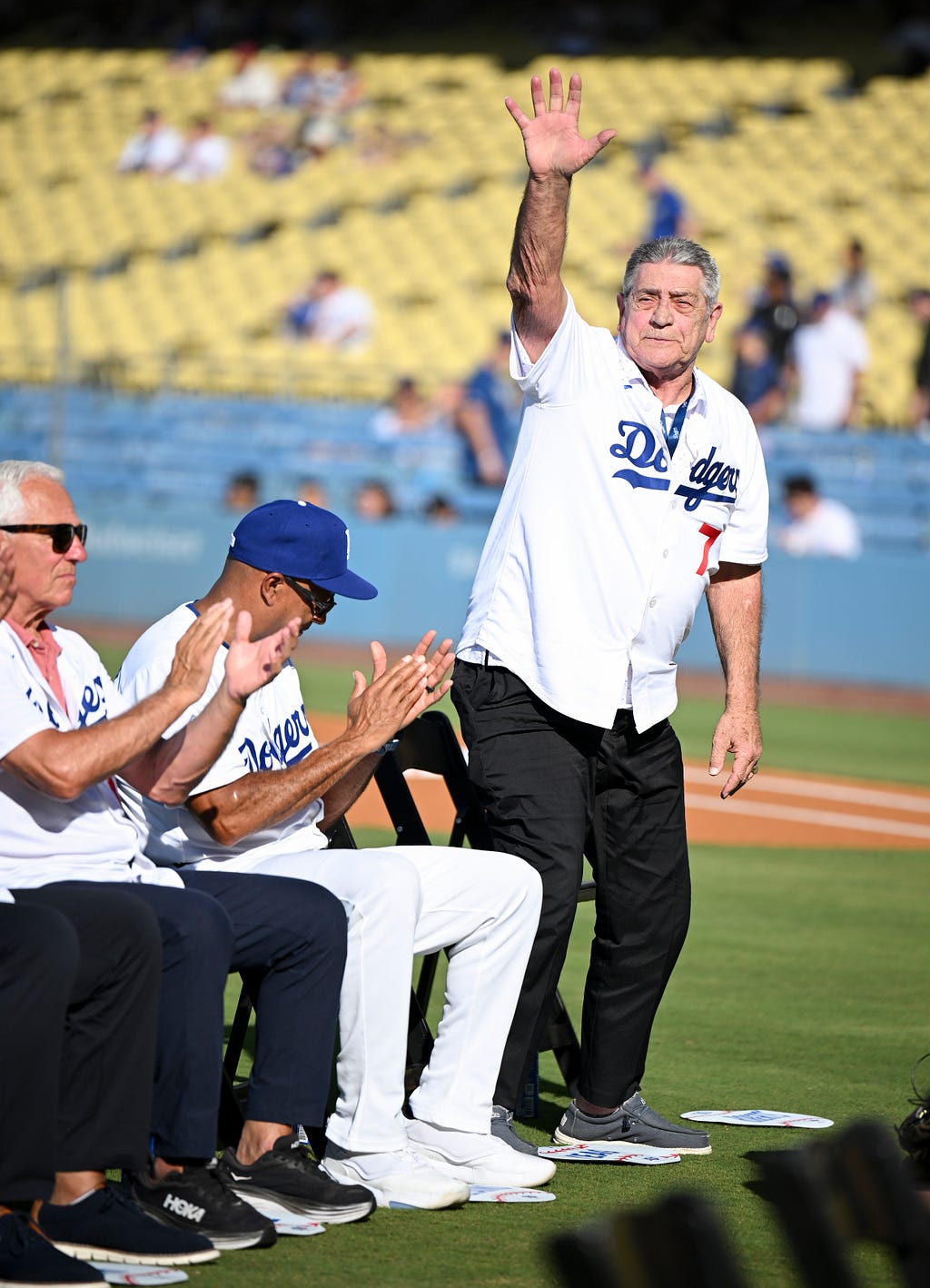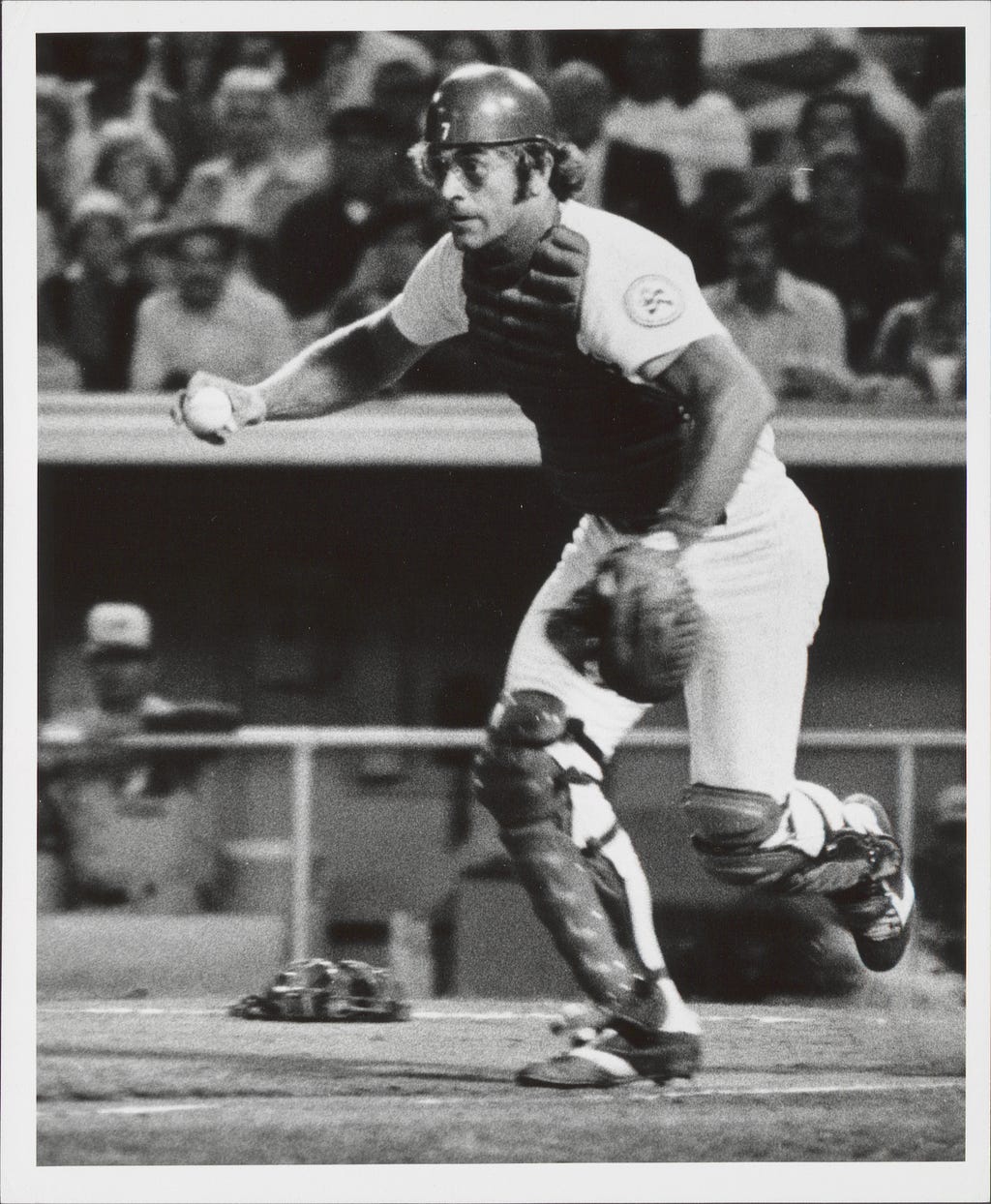Steve Yeager has always felt at home with LA

by Mark Langill
At all stages of his baseball career, Steve Yeager stood up for himself, although for a brash catcher unafraid of home-plate collisions, getting back up sometimes proved the bigger challenge.
The West Virginia native was the Dodgers’ fourth-round selection in the June 1967 First-Year Player Draft out of Meadowdale High School in Dayton, Ohio. During his first three seasons in pro ball, Yeager compiled cumulative batting averages of .171, .153, and .152 in 97 games between rookie-level and Double-A classifications.
When his staff was deciding which players to release after the 1969 season, Minor League vice president Bill Schweppe backed Yeager because of his throwing arm and tenacious attitude when calling a game.
Those qualities would serve Yeager throughout his 14-year career with the Dodgers from 1972 to 1985. The 6-foot, 190-pound Yeager was the vocal leader of the famous Dodger infield that included first baseman Steve Garvey, second baseman Davey Lopes, shortstop Bill Russell and third baseman Ron Cey. He ranks third on the all-time Los Angeles list for most games caught (1,181) behind Mike Scioscia (1,395) and John Roseboro (1,199).
Yeager, 75, is the recipient of the third annual Tommy Lasorda I Bleed Dodger Blue Award, an honor given to a member of the Los Angeles Dodger community that embodies the passion, enthusiasm and love for the Dodgers that Tommy Lasorda possessed.
“Baseball is probably one of my first true loves ever, other than my mother and family,” Yeager said in a 2007 interview when he was a Minor League coach in the Dodger farm system. “I enjoy the ups and the downs. I enjoy winning. Tomorrow, we have a chance to do something better than we did today. That’s the beauty of the game. Every game is different.”

Early in his Major League career, the Dodgers’ catching platoon combined Yeager’s defense with the power of Joe Ferguson, who could also play the outfield. Ferguson was traded to St. Louis on June 15, 1976, for outfielder Reggie Smith.
“Yeager took charge of the infield,” Russell says. “He was always confident of his throwing abilities. (Hall of Famer) Lou Brock of the Cardinals would get on base and start yelling, ‘Hey Steve. I’m going run.’ Yeager would yell back, ‘Don’t embarrass yourself, Lou.’”
Al Downing, who pitched for the Dodgers from 1971 to 1977, fondly remembers Yeager’s rookie season in 1972. Even though Downing was coming off a 20-win campaign in 1971, he describes Yeager’s fundamental catching style with a touch of “vociferousness.”
“What impressed me was how strong Yeager set up behind home plate,” Downing says. “I hadn’t seen a young catcher do that in a long time. He wasn’t favoring one corner or another. You could pitch to his body: left shoulder, right shoulder, left knee, right knee. And that’s what a pitcher likes. He doesn’t want to throw to a catcher’s chest protector because those are home runs.
“He also wasn’t afraid to tell an older pitcher, ‘C’mon, throw that stuff over the plate,’ because it made them quit nibbling around the strike zone.”
Yeager survived two career-threatening incidents. On Sept. 6, 1976, in San Diego, Yeager was standing in the on-deck circle when a piece of Russell’s broken bat lodged in his neck. Nine splinters were removed from his neck, barely missing his windpipe.
On Aug. 24, 1977, Yeager was involved in a home plate collision with 6-foot-5, 250-pound Dave Parker at Pittsburgh’s Three Rivers Stadium that knocked Yeager out of the lineup for a week. With his trademark humor, Yeager joked “Did anyone get the license number of the truck that hit me?”
At the plate, Yeager compiled a .228 batting average with 102 home runs and 410 RBI. He appeared in four World Series, including the 1981 Fall Classic when he was named a tri-MVP, along with teammates Ron Cey and Pedro Guerrero, when the Dodgers defeated the New York Yankees in six games.

Dodger broadcaster Rick Monday, an outfielder with Los Angeles from 1977 to 1984, has remained friends with Yeager since their playing days when the pair roomed together on the road. Monday recently sent Yeager a text message, saying he felt Yeager was the “brother I never had.”
“Steve never wanted to be embarrassed as a catcher,” Monday said. “His idea of being embarrassed was having to turn his back to the pitcher and go retrieve a baseball that was behind him. Steve believed that he should be able to stop everything that is being thrown. Whether high or low, inside or outside, it didn’t matter. His only objective was to block the baseball.”
Although best known for his defense, Yeager also hit one of the most dramatic home runs in Dodger history during Game 5 of the 1981 World Series. Tied at two games apiece, the winner would head back to New York with a 3–2 series lead.
New York left-hander Ron Guidry carried a 1–0 lead into the seventh inning. With one out, Pedro Guerrero hit a game-tying home run into the Left Field Pavilion.
Next to the plate was Yeager, who during the 1981 regular season batted .209 in 196 at-bats with three home runs and seven RBI. On a 1–2 count, Yeager jumped on a Guidry fastball for another home run to left field. Yeager’s second home run of the series gave left-handed Jerry Reuss all he needed for a complete-game 2–1 victory.
In 21 career World Series games, Yeager batted .298 with four home runs and 10 RBI.
For Monday, watching Yeager become a World Series-hitting hero was special, knowing the pride Yeager felt in all aspects of his game.
“I think in every major sporting event, the person who comes up big was the one you spent the least amount of time discussing in the scouting report, Monday says. “Steve may have been overlooked in the lineup; he didn’t hit for a high average during the regular season. But when it comes to clutch moments, everyone can do something they weren’t expected to do. Steve always expected to do it. He had higher expectations of himself than anyone else.”
Steve Yeager always felt at home with LA was originally published in Dodger Insider on Medium, where people are continuing the conversation by highlighting and responding to this story.